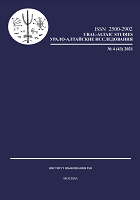ЕНИСЕЙСКИЕ РУНИЧЕСКИЕ НАДПИСИ ЯР-ХОТО (ИЗ НАХОДОК ПЕРВОЙ АРХЕОЛОГИЧЕСКОЙ ЭКСПЕДИЦИИ АКАДЕМИИ НАУК В ВОСТОЧНЫЙ ТУРКЕСТАН)
YENISEI RUNIC INSCRIPTIONS OF YAR-KHOTO (FROM THE FINDS OF THE FIRST ARCHAEOLOGICAL EXPEDITION OF THE ACADEMY OF SCIENCES TO EAST TURKESTAN)
Author(s): Igor L. KyzlasovSubject(s): Archaeology, Regional Geography, Middle Ages, 19th Century, History of Religion
Published by: Институт языкознания Российской академии наук
Keywords: East Turkestan; Turfan oasis; Yar-khoto; cave monastery; Yenisei runic writing; northern Manichaeism;
Summary/Abstract: In 1898, Dmitry A. Klements examined a small cave monastery in the Turfan oasis near the ancient city of Yar-Khoto. On the walls of two residential caves (nos. 3 and 6), 13 graffiti in the so-called Yenisei runic script were discovered and copied. Upon Klements' returning to St. Petersburg, the inscriptions were immediately studied and identified by Academician Wilhelm Radloff (in Russian - Vasily V. Radlov), who published four prints of the inscriptions, their reading and translation. Later, using archival copies, all graffiti were examined and read by Marcel Erdal. Turkologists, including Sergei G. Klyashtomyi, considered them to be marks of passing travelers. New insights and readings offered in this article link these inscriptions with the numerous Manichean prayer inscriptions made in the Yenisei runes known in the Sayan-Altai highlands. Based on the accumulation of such inscriptions in Southern Siberia, the places where Manichean monasteries existed in the early Middle Ages have been identified. Therefore, graffiti near Yar-Khoto were also left by monks who came from the Ancient Khakass state, and this was done in the 9th-10th centuries. The cave monastery surveyed in 1898 was Manichean, as indicated by the form of its central temple (cave 4) described in written sources, which had five sacred chambers, mandatory for such places of worship. Further study of the inscriptions should proceed from their religious purpose and their belonging to the northern, Siberian-Turkic version of Manicheism.
Journal: Урало-алтайские исследования
- Issue Year: 2021
- Issue No: 04 (43)
- Page Range: 69-83
- Page Count: 15
- Language: Russian

